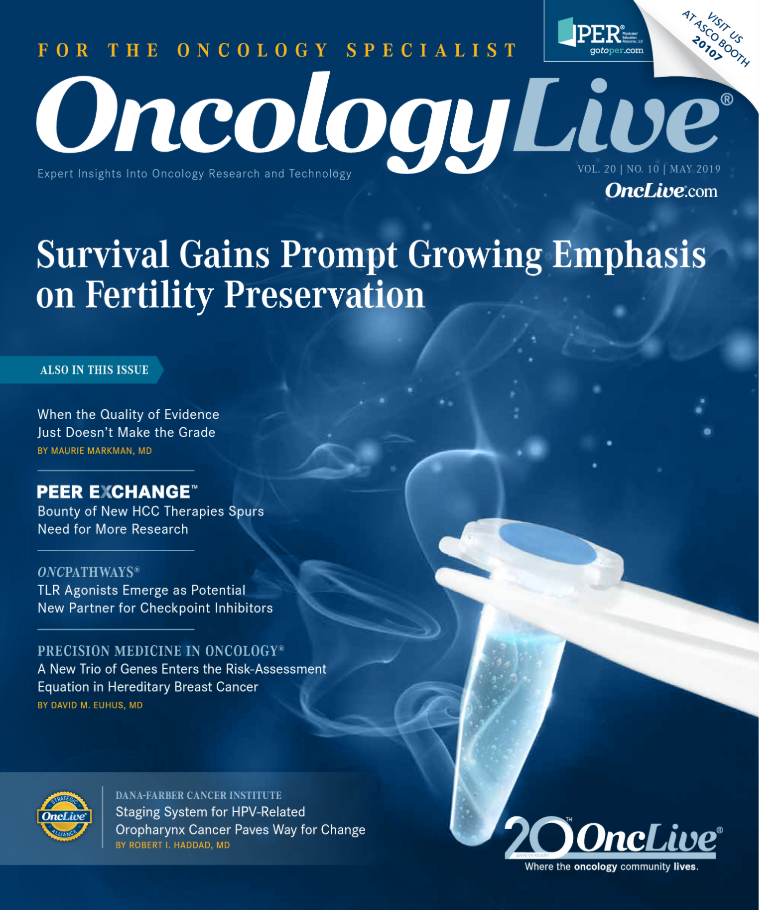Publication
Article
Oncology Live®
When the Quality of Evidence Just Doesn't Make the Grade in Cancer Care
Author(s):
The oncology clinical and research communities should demand that essential clinical trials and objectively valid evidence for efficacy and toxicity be obtained and reported before any regulatory agencies or national/international cancer societies support this strategy as a “standard of care” for cancer pain management.

Maurie Markman, MD
Some subjects in clinical medicine appear to be out-of bounds for open discussion. Consider the recent story in an otherwise prudent newspaper (The Jerusalem Post) that a pharmaceutical company that had only tested a novel drug in mice would have “a cure for cancer within a year.”1 Of course, once it was printed in this newspaper, other media outlets reported the same nonsense. So, the question to be asked is: To what degree should reputable journalists and mainstream news organizations ensure at least a modest degree of authenticity in their reporting?
Or consider the provocative commentary published in the industry-leading scientific journal Nature, which asked the deeply unsettling question of whether the international research community needs to confront the problem of systematic fraud.2 The writer highlighted her own examination of scientific misconduct that extends beyond individual investigators and may be ingrained in specific systems or regions of the world. Clearly, this is a most unpleasant topic but perhaps one that should be addressed.
Finally, in this brief introduction to the arena of difficult topics, we turn to the issue of the level of evidence in clinical medicine and research that should be required before a specific approach (eg, diagnostic, therapeutic) is allowed to leave the realm of hypothesis or investigation and become an acceptable standard of care. This is not a novel question. An analysis published more than a decade ago noted that of 1016 systematic reviews undertaken by the Cochrane Collaborative, almost half (49%) found that the available evidence did not support a conclusion of either benefit or harm for the intervention.3 So, we need to ask about the adequacy of the quality of the evidence we have that indicates utility in clinical medicine in general and cancer management in particular.
At this point, I turn the focus to a more contemporary problem: the scourge of opioid abuse in this country. Those reading this commentary are no doubt well aware of the devastating impact of this epidemic on individuals, families, and communities. Recently, stories about shocking behavior by some to increase profit from these drugs at the expense of individuals and society made the evening news on an almost nightly basis.
Perhaps even more distressing is the appallingly low level of evidence medical and pharmaceutical company communities have employed to imply that this class of potent pharmaceutical agents was safe for noncancer-related chronic pain.4 Now, phase III, randomized trials finally being conducted in common clinical settings have revealed that nonopioid medications provide equivalent pain relief without the attendant risks of addiction.5 Fortunately, the FDA is finally mandating that potent longacting opioids currently approved for chronic noncancer pain be tested in appropriately designed, evidence-based trials to demonstrate clinical utility and safety for any patient defined as having chronic pain from a cancer- or noncancer-related issue.
Although there is a well-recognized unique role for opioids in end-of-life cancer care, many now recognize that there have been serious consequences to the previous assumption that opioids carried only a limited risk of addiction within the general population of patients with cancer. One concerning study noted that as many as 10% of opioid-naïve patients undergoing curative cancer surgery appeared to become persistent users.6 And, in a poignant and quite distressing commentary, an oncologist recently described opioid addictions among patients with cancer as being “harder to treat than leukemia.”7 As this physician highlighted, there are limited alternatives for pain management in this patient population and an absence of solid evidence supporting an optimal approach in a variety of highly clinically relevant cancer settings.
A difficult aspect of the current debate regarding the opioid epidemic is the diminished availability of truly essential end-of-life pain relief and the creation of an excessive, bureaucratic burden on the patient with cancer, the patient’s family, and the provider community.8 Imagine a patient whose last days are spent in severe pain because an arbitrary, completely non — evidence-based restriction on the number of milligrams of opioids permitted in a 5- or 7-day period made it impossible for a local pharmacy to honor an opioid prescription.
Finally, in this discussion of the absence of evidence supporting pain management, it should be noted that there are troubling efforts to quickly discover alternative approaches to pain management. These include a strategy that is potentially fraught with its own abuse issues.9,10 To date, the public discussion regarding the substitution of cannabinoids for opioids as a pain management strategy appears to have focused on chronic noncancer related pain, but there is no reason to think this strategy will not soon be considered for cancer treatment also.
In general, the use of cannabinoids for medical purposes is highly complex, and I have no intent in this brief commentary to deal with the questions of clinical utility versus recognized toxicities of the various forms of cannabinoids. Further, although it is well understood that the absence of essential, valid evidence (favorable or unfavorable) is largely due to decades-old highly restrictive federal regulations surrounding the conduct of clinical research with cannabinoids, the fact remains that today it is difficult to know how this class of potent drugs may benefit the patient with cancer and, in particular, whether these agents may be considered as substitutes for opioid medications in patients with malignancy-associated pain.
Hopefully, the oncology clinical and research communities will demand that essential clinical trials and objectively valid evidence for efficacy and toxicity (including age-related adverse events) be obtained and reported before any regulatory agencies or national/international cancer societies support this strategy as a “standard of care” for cancer pain management.
References
- Jaffee-Hoffman M. A cure for cancer? Israeli scientists may have found one. Jerusalem Post. January 28, 2019. jpost.com/HEALTH-SCIENCE/A-cure-for-cancer-Israeli-scientists-say-they-think-they-found-one-578939. Accessed April 24, 2019.
- Byrne J. We need to talk about systematic fraud. Nature. 2019;566(7742):9. doi: 10.1038/d41586-019-00439-9.
- El Dib RP, Atallah AN, Andriolo RB. Mapping the Cochrane evidence for decision making in health care. J Eval Clin Pract. 2007;13(4):689-692. doi: 10.1111/j.1365-2753.2007.00886.x.
- Ashburn MA, Fleisher LA. Increasing evidence for the limited role of opioids to treat chronic noncancer pain. JAMA. 2018;320(23):2427-2428. doi: 10.1001/jama.2018.19327.
- Krebs EE, Gravely A, Nugent S, et al. Effect of opioid vs nonopioid medications on pain-related function in patients with chronic back pain or hip or knee osteoarthritis pain. JAMA. 2018;319(9):872-882. doi: 10.1001/jama.2018.0899.
- Lee JS, Hu HM, Edelman AL, et al. New persistent opioid use among patients with cancer after curative-intent surgery. J Clin Oncol. 2017;35(36):4042-4049. doi: 10.1200/JCO.2017.74.1363.
- Loren AW. Harder to treat than leukemia - opioid use disorder in survivors of cancer. N Engl J Med. 2018;379(26):2485-2487. doi: 10.1056/NEJMp1812850.
- Szalavitz M. When the cure is worse than the disease. The New York Times. February 9, 2019. nytimes. com/2019/02/09/opinion/sunday/pain-opioids.html. Accessed April 24, 2019.
- Voelker R. States move to substitute opioids with medical marijuana to quell epidemic. JAMA. 2018;320(23):24082410. doi: 10.1001/jama.2018.17329.
- Humphreys K, Saitz R. Should physicians recommend replacing opioids with cannabis? JAMA. 2019;321(7):639640. doi: 10.1001/jama.2019.0077.



























%20(2)%201-Recovered-Recovered-Recovered-Recovered-Recovered-Recovered-Recovered-Recovered-Recovered-Recovered-Recovered-Recovered-Recovered-Recovered-Recovered-Recovered-Recovered.jpg?fit=crop&auto=format)
%20(2)%201-Recovered-Recovered-Recovered-Recovered-Recovered-Recovered-Recovered-Recovered-Recovered-Recovered-Recovered-Recovered-Recovered-Recovered-Recovered-Recovered-Recovered.jpg?fit=crop&auto=format)
